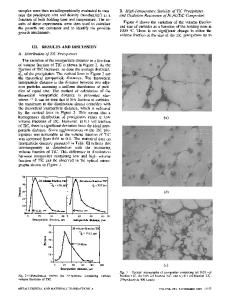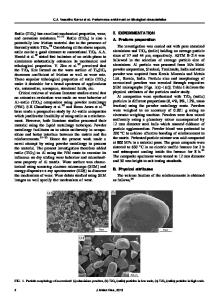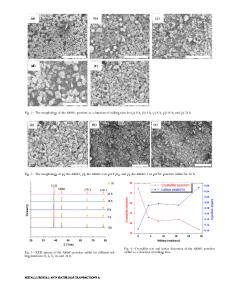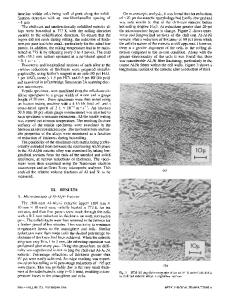Ni 3 AI intermetallic particles as wear-resistant reinforcement for Al-base composites processed by powder metallurgy
- PDF / 2,915,385 Bytes
- 8 Pages / 597.28 x 777.28 pts Page_size
- 28 Downloads / 282 Views
I.
INTRODUCTION
ALUMINUM alloy matrix composites (AMCs) reinforced with ceramics have been considered suitable for a wide variety of applications where lightweight components are required (i.e., the automobile industry and marine structures). The tribological characteristics of AMCs reinforced with ceramics have been extensively investigatedE1-~41to determine the effect of different combinations of matrix alloy and type, size, shape, and volume fraction of reinforcement on wear behavior. The resultant matrix/reinforcement bonding in these AMCs is often undesirable as it may induce reduced ductility and fracture toughness. Thus, the introduction of new reinforcements is being investigated5 ~s 19] As reported by Omura et al.,[15] Yamada and Unakoshi I:~ proposed that intermetallics of the Ni-A1 system would be excellent candidates for reinforcement of Al-base cast alloys because they exhibit a high level of hardness, elastic modulus, and melting temperature. Omura et al. found that composite castings containing 5 vol pct of NiAI intermetallic dispersed into an Al-base alloy exhibited a wear resistance as good as conventional die casting AMCs but with considerably better ductility. Varint2~] studied AMCs reinforced with intermetallic ribbons and concluded that they might be appropriate for high-temperature applications, particularly when the intermetallic is Ni3Al-base. One of the most important advantages of employing Ni3A1 as a reinforcement can be inferred from the fact that its thermal expansion coefficient, 13 • 10-6 K -1, at room temperature t22] is much closer to that of A1 alloys, 18 to 24 • 10 6 K - l , [23] when compared to those of ceramic reinforcements,
C. DIAZ is Graduate Student, formerly with the Physical Metallurgy Depar~nent (CENIM-CSIC). J.L. GONZa~EZ-CARRASCO, G. CARUANA, and M. LIEBLICH*, Research Scientists, are with the Physical Metallurgy Department, Centro Nacional de InvestigacionesMetalfirgicas(CENIM-CSIC), Avda. Gregofio del Amo 8, 28040 Madrid, Spain. Manuscript submitted August 21, 1995. *To whom correspondence should be sent. METALLURGICALAND MATERIALSTRANSACTIONSA
for example, 3.3 • 10 -6 K -1 for SiC. I24] This smaller difference in thermal expansion coefficients will lower the residual stresses that appear at reinforcement/matrix interfaces while exposing the composite to thermal cycles. A lower degree of failure originated at the particle/matrix interface can, therefore, be expected, t25] In addition, because heat generated during friction[3,4,9a7as] impairs wear behavior, the high thermal stability of Ni3A1 in an aluminum matrix that was observed after long-term annealing at 300 ~ makes this intermetallic an advantageous reinforcement for a wear-resistant composite. The enhanced hightemperature behavior of the composite will promote better deformation resistance at high wear loads and speeds than unreinforced A1.[9] In the present work, the use of Ni3A1 as wear-resistant reinforcement for Al-base composites was investigated. For the preparation of the AMC, a powder metallurgy (P
Data Loading...











